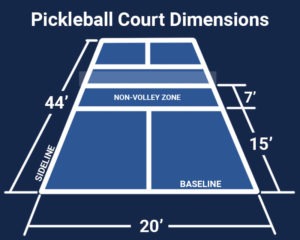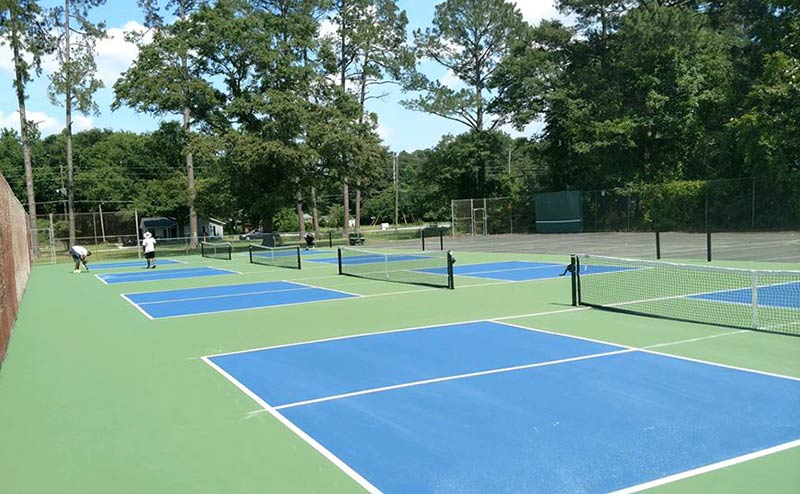Pickleball Court Construction-- Vital Tips for a Resilient Court
Pickleball Court Construction-- Vital Tips for a Resilient Court
Blog Article
Lasting Practices in Pickleball Court Building And Construction You Ought To Know
As the popularity of pickleball continues to rise, so as well does the requirement for sustainable practices in court building and construction. The impact of these techniques prolongs far past the court itself.
Choosing Eco-Friendly Products
Choosing eco-friendly products is an essential action in the building and construction of sustainable pickleball courts. The selection of lasting materials not just decreases ecological effect however likewise enhances the long life and performance of the court. Trick materials consist of reused rubber for the surface, which provides excellent resilience and shock absorption while drawing away waste from land fills.
In addition, making use of in your area sourced materials reduces transportation emissions and sustains regional economic climates. Pickleball court construction. Using native hardwoods for fence and seating can supply a lasting aesthetic while making sure strength against the components.
Integrating absorptive products for court structures can further add to sustainability by permitting natural water drain and decreasing overflow. These options not just safeguard regional ecological communities but additionally advertise healthier play environments.
Efficient Water Drainage Solutions
While the choice of eco-friendly products is essential, executing efficient water drainage remedies is just as essential for keeping lasting pickleball courts. Appropriate drain not just secures the court surface from water damage however additionally reduces disintegration and runoff, advertising environmental stability.
Reliable drain systems can consist of permeable paving, which enables water to penetrate the ground rather than pooling on the surface. This reduces the chance of standing water, which can result in mold and mildew and other maintenance problems. Furthermore, including tactically positioned water drainage channels and swales can direct excess water far from the court area, guaranteeing a completely dry having fun surface and preventing soil erosion.
Utilizing native plants in the landscaping around the courts can further enhance drain by absorbing excess water and minimizing runoff. These plants require less irrigation and promote biodiversity, lining up with lasting practices.
In addition, it is vital to on a regular basis maintain the drain system to ensure its long-lasting efficiency. This consists of clearing particles and surveillance for obstructions. By focusing on efficient drain remedies, pickleball court producers can dramatically add to the sustainability and longevity of the center, eventually benefiting both players and the setting.
Energy-Efficient Illumination Options
As the demand for pickleball remains to grow, incorporating energy-efficient lighting choices into court layout has become increasingly crucial for sustainability. Traditional illumination systems frequently take in excessive energy, adding to greater operational expenses and ecological effect. Adopting modern, energy-efficient technologies is vital for both brand-new constructions and remodellings.
LED (Light Emitting Diode) lights stands apart as a leading choice as a result of its longevity and energy cost savings (Pickleball court construction). Compared to standard lighting, LEDs utilize about 75% much less power and can last as much as 25 times longer, dramatically lowering maintenance prices. Moreover, the directional nature of LED lighting decreases light contamination, ensuring that illumination is concentrated on the court as opposed to bordering areas.

Lasting Surface Alternatives
Exploring sustainable surface area options for pickleball courts has gained traction amongst builders and players alike. The focus on eco-friendly materials not just straightens with the growing ecological recognition but additionally enhances the performance and sturdiness of the courts.
One preferred option is making use of recycled rubber, which can be sourced from made use of tires. This product provides outstanding shock absorption, minimizing the risk of injuries for players while promoting sustainability. In addition, modular tiles made from recycled plastics provide an additional feasible option. These ceramic tiles are very easy to install and change, and their Find Out More adaptability permits various court setups.
All-natural lawn courts are also emerging as a lasting choice, advertising biodiversity and decreasing the warmth island impact. However, they require routine upkeep and water, which might not straighten with all sustainability objectives.

Water Conservation Strategies

One more reliable strategy involves the setup of rainwater harvesting systems. These systems gather and store rain for usage in keeping court surfaces and landscape design. This approach not only conserves drinkable water but additionally lowers reliance on municipal resources.
Furthermore, using drought-resistant landscaping around the courts is necessary. Native plants require much less water and are better adapted to local climate problems, hence lowering overall water intake. Furthermore, using efficient irrigation systems, such as drip watering, makes sure that water is delivered straight to plant origins, lessening dissipation and waste.
Conclusion
Incorporating lasting techniques in pickleball court building and construction considerably contributes to ecological preservation and source performance. By focusing on these practices, the building and construction of pickleball courts can line up with broader ecological objectives while advertising long life and performance this hyperlink within neighborhoods.
As the appeal of pickleball continues to climb, so also does the need for lasting methods in court construction.Selecting environment-friendly products is a crucial step in the construction of sustainable pickleball courts. By focusing on energy-efficient lighting options, pickleball court erectors can contribute to a much more lasting future while meeting visit the website the requirements of stakeholders and players alike.Including lasting surface area alternatives not only enhances the efficiency of pickleball courts but also paves the way for applying reliable water conservation methods.Including lasting methods in pickleball court building and construction significantly adds to ecological preservation and source effectiveness.
Report this page